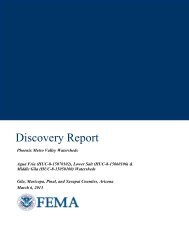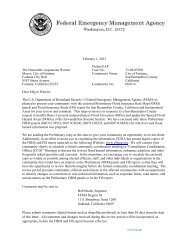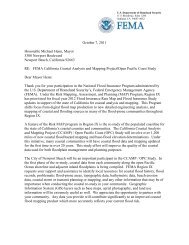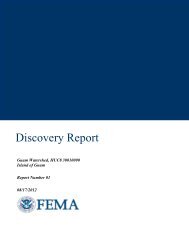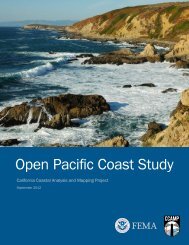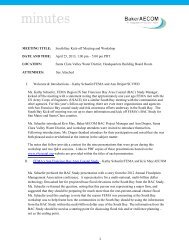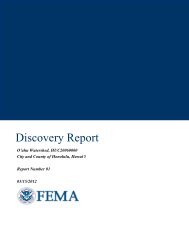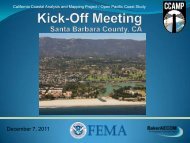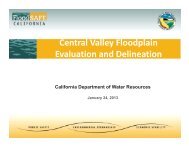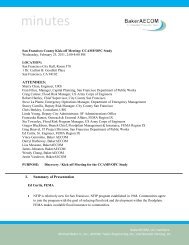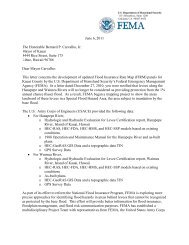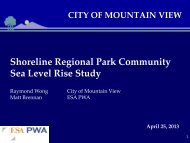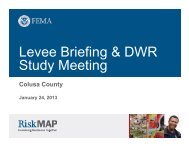YAVAPAI COUNTY, ARIZONA Federal Emergency ... - FEMA Region 9
YAVAPAI COUNTY, ARIZONA Federal Emergency ... - FEMA Region 9
YAVAPAI COUNTY, ARIZONA Federal Emergency ... - FEMA Region 9
You also want an ePaper? Increase the reach of your titles
YUMPU automatically turns print PDFs into web optimized ePapers that Google loves.
To minimize the impact of the levee recognition and certification process, <strong>FEMA</strong><br />
issued “Procedure Memorandum No. 43 – Guidelines for Identifying<br />
Provisionally Accredited Levees” on March 16, 2007. These guidelines allow<br />
issuance of the FIS and FIRM while levee owners or communities compile full<br />
documentation required to show compliance with 44 CFR 65.10. The guidelines<br />
also explain that a FIRM can be issued while providing the communities and<br />
levee owners with a specified timeframe to correct any maintenance deficiencies<br />
associated with a levee and to show compliance with 44 CFR 65.10.<br />
<strong>FEMA</strong> contacted the communities within Yavapai County to obtain data required<br />
under 44 CFR 65.10 to continue to show the levees as providing protection from<br />
the flood that has a 1-percent annual chance of being equaled or exceeded in any<br />
given year.<br />
<strong>FEMA</strong> understood that it may take time to acquire and/or assemble the<br />
documentation necessary to fully comply with 44 CFR 65.10. Therefore, <strong>FEMA</strong><br />
put forth a process to provide the communities with additional time to submit all<br />
the necessary documentation. For a community to avail itself of the additional<br />
time, it had to sign an agreement with <strong>FEMA</strong>. Levees for which such agreements<br />
were signed are shown on the final effective FIRM as providing protection from<br />
the flood that has a 1-percent annual chance of being equaled or exceeded in any<br />
given year and labeled as a Provisionally Accredited Levee (PAL). Communities<br />
have two years from the date of <strong>FEMA</strong>’s initial coordination to submit to <strong>FEMA</strong><br />
final accreditation data for all PALs. Following receipt of final accreditation data,<br />
<strong>FEMA</strong> will revise the FIS and FIRM as warranted.<br />
<strong>FEMA</strong> coordinated with the local communities, Bureau of Reclamation, and other<br />
organizations to compile a list of levees based on information from the FIRM and<br />
community provided information.<br />
Approximate analyses of “behind levee” flooding were conducted for all the<br />
levees to indicate the extent of the “behind levee” floodplains. The methodology<br />
used in these analyses is discussed below.<br />
Levee-like structure ID # 3 and levee structure ID #16 are located on Lynx Creek.<br />
Based upon topographic information and aerial imagery from the USGS we<br />
developed a hydrologic and hydraulic analysis for this portion of Lynx Creek.<br />
The watershed to these structures had a drainage area of 40 sq. mi. and using the<br />
USGS National Flood Frequency equations for Arizona the discharge was<br />
computed to be 12,280 cfs. Using the USACE HEC-RAS hydraulic model an<br />
area of flooding in the event of failure of the levees was determined.<br />
Levee-like structures with inventory ID # 4, 5 and 6 are located on Cienega<br />
Creek. Based on the FIS and topographic information from the USGS (i.e., 10m<br />
DEMs), there is no depression behind these levee-like structures and they are not<br />
providing protection from flood hazards. Therefore no change in the floodplain is<br />
recommended at this location.<br />
Levee-like structure with inventory IDs #12 is located on Skull Valley Wash.<br />
Based on the FIS and topographic information from the USGS (i.e., 10m DEMs),<br />
48




